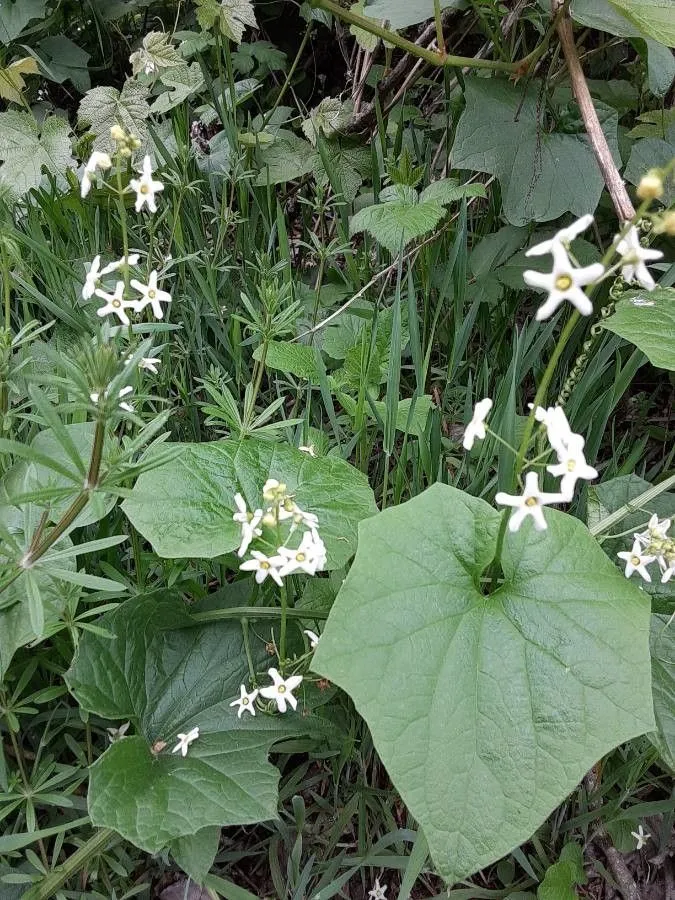
Author: (Naudin) Greene
Bibliography: Leafl. Bot. Observ. Crit. 2: 36 (1910)
Year: 1910
Status: accepted
Rank: species
Genus: Marah
Vegetable: False
Observations: California to Nevada
The California manroot, scientifically known as Marah fabacea, is a fascinating and distinctive member of the Cucurbitaceae family. First described in 1910 by Greene, based on earlier classifications by Naudin, this plant has since intrigued botanists and nature enthusiasts alike.
Native to the western regions of the United States, the California manroot is predominantly found from California to Nevada. Its habitat spans a variety of environments, reflecting the plant’s adaptability and resilience in different ecological conditions. This perennial vine makes its presence known through vigorous growth patterns and robust root systems.
The plant is easily recognizable by its large, lobed leaves and intricate tendrils that allow it to climb and sprawl across the landscape. Blooming in the spring, Marah fabacea produces small, greenish-white flowers that are often overlooked due to their subtle appearance but are crucial for pollinators in their habitats. Following the flowering period, the plant yields distinctive, spiny fruit that can be quite conspicuous.
One of the most striking features of the California manroot is its giant tuberous root, which can grow to significant sizes underground. This root serves as a storage organ, allowing the plant to survive through extended periods of drought, which are common in its native regions. The resilience and survival tactics of Marah fabacea make it a subject of study for those interested in plant adaptations and strategies in arid climates.
In summary, the California manroot is a notable example of botanical ingenuity. Its presence from California to Nevada showcases its adaptability, while its unique morphological characteristics make it a plant of interest both scientifically and horticulturally. This enduring species continues to thrive and inspire within the diverse landscapes of western North America.
Eng: california manroot, valley manroot
En: California manroot, Valley manroot
Taken Apr 23, 2022 by Brigitte Huber-Jordi (cc-by-sa)
Taken May 21, 2022 by calathea1398 (cc-by-sa)
Taken May 18, 2019 by Burl Travis (cc-by-sa)
Taken May 1, 2021 by Brittany Dobson (cc-by-sa)
Taken Jul 13, 2022 by Barb T (cc-by-sa)
Taken Jan 30, 2016 by EOL − Stacie Wolny (cc-by-nc-sa)
Taken Feb 15, 2016 by EOL − matty (cc-by-nc)
Taken Apr 15, 2006 by EOL − Steve Matson (cc-by-nc)
Taken May 1, 2021 by Brittany Dobson (cc-by-sa)
Taken Jul 13, 2022 by Barb T (cc-by-sa)
Taken Mar 29, 2015 by EOL − JK Johnson (cc-by-nc)
Taken Jul 13, 2007 by EOL − J. E.(Jed) and Bonnie McClellan (cc-by-nc-sa)
Taken May 15, 2009 by EOL − Barry Rice (cc-by-nc-sa)
Taken Mar 31, 2022 by sophie v (cc-by-sa)
Taken Jul 13, 2022 by Barb T (cc-by-sa)
Growth habit>: Vine, Forb/herb
Family: Myrtaceae Author: (F.Muell.) K.D.Hill & L.A.S.Johnson Bibliography: Telopea 6: 402 (1995) Year: 1995 Status:…
Family: Rubiaceae Author: Pierre ex A.Froehner Bibliography: Notizbl. Bot. Gart. Berlin-Dahlem 1: 237 (1897) Year:…
Family: Sapindaceae Author: Koidz. Bibliography: J. Coll. Sci. Imp. Univ. Tokyo 32(1): 38 (1911) Year:…
Family: Asteraceae Author: A.Gray Bibliography: Pacif. Railr. Rep.: 107 (1857) Year: 1857 Status: accepted Rank:…
Family: Fabaceae Author: Medik. Bibliography: Vorles. Churpfälz. Phys.-Ökon. Ges. 2: 398 (1787) Year: 1787 Status:…
Family: Aspleniaceae Author: (Cav.) Alston Bibliography: Bull. Misc. Inform. Kew 1932: 309 (1932) Year: 1932…